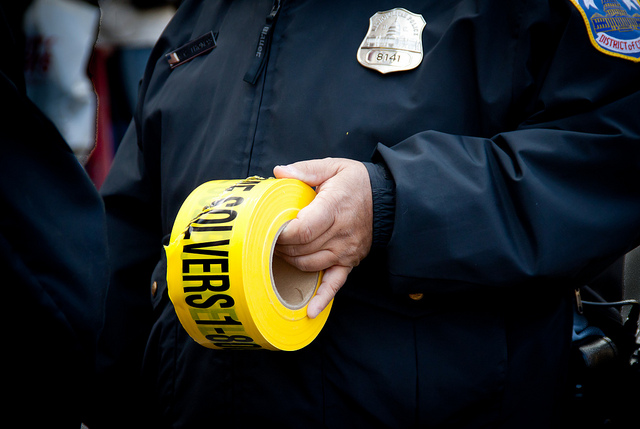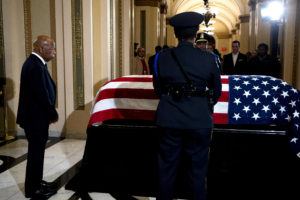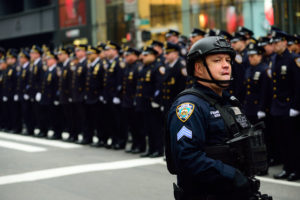Police Investigating Themselves Leads to Predictable Results
Time and again, officers are involved in custody deaths that are ruled accidents. A pair of reporters explores how they game the system. Victoria Pickering / Flickr
Victoria Pickering / Flickr
What follows is a conversation between Jacqueline Luqman, Stephen Janis and Taya Graham of the Real News Network. Read a transcript of their conversation below or watch the video at the bottom of the post.
JACQUELINE LUQMAN: I’m Jacqueline Luqman with The Real News Network, coming to you from Baltimore.
Despite a national outcry and increased attention, police killings of African American men continue to roil communities across the country. Here in Maryland, the recent death of Anton Black, a 19-year-old former high school track star, has brought controversy and turmoil to the small Eastern Shore town of Greensboro, Maryland, where he lived. In September, police chased him to his mother’s home, where two officers and one civilian tasered him, wrestled him to the ground, and it’s during that arrest that Anton Black died. The Medical State Examiners Board ruled his death an accident, and that decision has caused controversy because The Real News consulted an independent pathologist that determined that Black’s death was the result of positional asphyxiation, meaning that his death was not an accident.
But The Real News investigation did not stop there. Our reporters, Taya Graham and Stephen Janis, looked into other cases of police involved deaths that had also been ruled accidents. And what they found is the topic of our discussion today. So thank you, Taya and Steven, for joining me today on The Real News Network.
TAYA GRAHAM: Thank you for having us.
STEPHEN JANIS: Thank you for having us.
JACQUELINE LUQMAN: This case is not only troubling, but it turns out it’s not the only case like it that you have examined. But let’s start with the case of Anton Black. Give me a little overview of what happened in this case.
TAYA GRAHAM: Certainly. Well, Anton Black, as you mentioned, was a 19-year-old with an incredibly bright future. He wasn’t only just a track star and a football star, but he was a budding model. He had actually just walked the catwalk in New York’s Fashion Week. So what happened was a white woman called 911 and said that she saw Anton abducting a boy. It turns out, the boy that Anton was walking down the street with was his 12 year old cousin. Whether or not they were roughhousing a bit or horseplaying, obviously this woman saw it in a particular way. She chose to call the police.
When the police arrived, Officer Tom Webster was on the scene. Officer Tom Webster’s interaction with Anton made him start to run away. Once he started running, another police officer, not in uniform, started chasing him, and that’s when Anton got really scared and started running home to his mother. There was also a man on a motorcycle, who was a civilian, who joined into the chase, which is something that’s actually not uncommon on the Eastern Shore, for citizens to get involved with policing, but we can talk about that another time. But for Anton, this all started with a white woman who called 911 on him. He was chased, tasered, and it led to his death, and the State Medical Examiner ruled this an accident.
JACQUELINE LUQMAN: So how did the State Medical Examiner’s office justify ruling this young man’s death an accident.
STEPHEN JANIS: Basically, the Medical Examiner, which we should note took four to five months to come up with this conclusion, used an underlying abnormality in his heart, which is not something that had caused any problems for him previously or there was even a medical fact about, because actually, he had had an electrocardiogram and it did not come up. So the Medical Examiner said that he had this underlying anatomical aberration that prompted him to basically die out when he was in the process of being arrested. The Medical Examiner also pointed to a psychological condition which really had nothing to do–bipolarity I guess, right?
TAYA GRAHAM: Yes, it was bipolar disorder.
STEPHEN JANIS: So really, using those two things. So it really doesn’t make any sense, because as the medical pathologist that we consulted, Dr. Cyril Wecht said, this had been something he’d lived with his whole life. I mean, as Taya pointed out, he was a track star, so obviously if he had a heart problem–which is not what this really is, it’s just an aberration, and there’s a big distinction there. It’s not like something that would be known as a medical condition, it’s just his heart is shaped a little differently.
TAYA GRAHAM: Right. It’s just a little bit different from the standard, just a slight aberration, which doesn’t mean that it’s actually pathological, that it would have caused him any trouble throughout his life.
JACQUELINE LUQMAN: So this raises the question. The term “underlying heart condition,” it doesn’t mean what we think it means, does it? It does not mean that Anton Black was sick and suffering from a heart condition that would have taken his life or ended his life anyway. So if that is the case, can it be said that if Anton Black had not had this interaction the way it happened with the police, even with this underlying heart condition, would he still be alive?
TAYA GRAHAM: Yes.
STEPHEN JANIS: Yes, because what we did is we consulted an outside medical pathologist, Dr. Cyril Wecht, who is pretty famous for doing–he worked on the Kennedy assassination and he’s been a President of the American Association of Pathologists. So he’s a pretty famous guy. And what he said was that this had nothing to do with a heart condition, this had to do with something called positional asphyxiation. Right now we’re going to be showing the video, which is from the body cam of one of the officers. And as you can see, the officer is lying across Anton’s body, and Anton is face down on the ground and has this fairly large man on him.
TAYA GRAHAM: A very large man on him. So positional asphyxiation, and this is what we learned from Dr. Cyril Wecht, is when someone is lying face down on the ground and someone else is laying on top of them. Sometimes it’s also called traumatic asphyxiation or riot crush, because it’s seen when there is a riot, a movement of people, and someone gets trampled and people step on top of them. So what happens is the person is on the ground and another body is placed on top of them and their lungs become compressed. They’re unable to breathe. And you would be surprised how little it takes, how little time it takes, for you to be deprived of oxygen, for it to cause a cardiovascular event or your death.
STEPHEN JANIS: So let’s listen to what Dr. Wecht said specifically about Anton’s case.
TAYA GRAHAM: Yes.
CYRIL WECHT: I strongly disagree with the final diagnosis that the cause of death was a coronary artery, anatomical aberration. That defect had been present in Mr. Black’s life his entire life and had not produced any problems to my knowledge from reading the reports. How convenient that he should have died from that defect at the time that he is being restrained in a position that has been barred, banned, and prohibited from various national police agencies throughout the country and elsewhere in the world. This is a classical case of positional asphyxiation in which somebody is placed face down and then someone leans on his back, presses down on his back, he’s tasered after several minutes, and then he goes limp. That’s a classical case of positional asphyxiation.
JACQUELINE LUQMAN: So I want to go back to positional asphyxiation, because this is fascinating to me. If we understand that in a riot situation, in a crowd situation, if someone falls on the ground and other people step on them or other people accidently fall on them, that that weight on a person’s body can cause death.
TAYA GRAHAM: Yes.
JACQUELINE LUQMAN: Then how is that not carried over? How is that not the same phenomenon in a situation where a teenage boy has a 250 pound adult man lying on his back?
TAYA GRAHAM: Well, the reason why it’s not the same phenomenon is because police officers are involved. It’s that simple. One of the problems is that in the Medical Examiner’s Office, when they are doing the autopsy, very often the same police officers who were involved in the incident that led to the death are in the autopsy room with the Medical Examiner.
JACQUELINE LUQMAN: Is that normal? Is that procedure or is that unusual?
STEPHEN JANIS: Well, according to A. Dwight Pettit, who is an attorney who also has litigated one of these cases of positional asphyxiation, it is very common. And we can listen and talk about the clip we have right here.
A. DWIGHT PETTIT: The police officers are right in the room. The police officers–I’ve seen in case after case where the police officers go into the autopsy, and I think they tend to intimidate the doctors.
JACQUELINE LUQMAN: So it’s common, but is it right?
STEPHEN JANIS: Great question.
TAYA GRAHAM: That’s a great question. I would have to give this as my opinion as someone who’s investigated these stories. I don’t think it’s right, because when you have a police officer guiding the autopsy, it can’t help but influence the way the doctor is perceiving the evidence in front of them. And I think a good example of this is in Anton Black’s case, because they said it was an underlying heart condition exacerbated by his bipolar disorder. If you had that body in the room and you were examining it, there is no way in doing an autopsy you could possibly know if someone had a mental health condition like bipolar disorder unless they had medicine in his system for it, which he did not. And that gives a sign that the officers were leading the Medical Examiner to the conclusion that the officers wanted to see.
STEPHEN JANIS: And why this is so critical, if you look at the coverage of Anton’s death, you’ll see once the Medical Examiner concludes it’s an accident, all the media starts reporting “accident, accident,” every headline you see “accident.” And suddenly, there’s no real imperative for the prosecutors to bring any sort of case against the police officers, because it says it’s an accident. I mean, the Medical Examiner plays a critical role in this, and if the police are influencing them, it’s the dilemma of police investigating themselves. So you don’t really have an impartial body here, and yet it’s critical to what happens later on.
JACQUELINE LUQMAN: So this is an interesting perspective, because I don’t think we usually think about the role of the Medical Examiner in police involved deaths. But here, we have a case, and not just one case, several cases, and probably more than what you two have investigated, where biased police rather are influencing what is supposed to be the unbiased entity in the process, which is the Medical Examiner’s office. So that leads us to the question, who appoints the Medical Examiner, where does the Medical Examiner come from?
TAYA GRAHAM: Great question.
STEPHEN JANIS: So there’s a board made up of a couple prominent physicians and the Baltimore City Health Commissioner, and it’s called the Board of Pathology or something. It’s a very small, obscure board, not elected, not appointed by anyone other than I think the governor or even themselves. And they are the people who sort of make the decision of who to hire to be the Chief Medical Examiner. So there’s really–and this is very different from other jurisdictions where what you have is a Coroner’s System where a Coroner is elected by the population, just like a State’s Attorney. Like Marilyn Mosby is a Baltimore Prosecutor, she’s elected. Many states have a Coroner who is an elected official, it doesn’t really have to be a medical pathologist. But here we have a system where it’s all centralized. And I think we could safely say an obscure board appoints them, so the accountability mechanisms are absent from this situation.
JACQUELINE LUQMAN: So even in light of the kind of nebulous nature of the Medical Examiner being appointed and the exposure that these questionable findings from the Medical Examiner’s office is highlighting, what recourse do citizens have when they now question the reputation, they now question the motives of the Medical Examiner in these cases. What can citizens do?
TAYA GRAHAM: That’s a good question. That’s really the problem here. There is such a thing as a Civilian Review Board, for example in Baltimore City, which is a body that’s connected to the Office of Civil Rights and Wage Enforcement. And if someone has experienced police brutality, discourtesy, they can file a complaint with the Civilian Review Board. However, once the Civilian Review Board makes a recommendation, they can recommend that an officer be disciplined or even be fired, they pass that onto the police department, but the police department has no obligation to do anything with that recommendation. So when it comes to police accountability, our citizens really have trouble holding them accountable.
STEPHEN JANIS: With the Medical Examiner’s Office, you can appeal a ruling, I think, for like 60 days. But in terms of the actual board, the only really way people have to fight back with this or to question it is through litigation. And in the case of litigation in terms of some of the other cases we’ve looked at, they went and they deposed the pathologist and actually questioned them. And we have a little piece of sound from A. Dwight Pettit where he talks about what happened in those depositions.
A. DWIGHT PETTIT: When we took the depositions of the doctors in the West case, they really did not back their own conclusions. When we got to the conclusions, “Well, I don’t remember,” or “I’m not sure, I didn’t really examine this,” well this is basically them saying, “Hey, there was another factor involved which I don’t want to get into.” The factor is that five or six police officers were sitting there while you were doing the autopsy, telling you what they wanted you to find.
STEPHEN JANIS: So as you can see, he felt from talking to these Medical Examiners that they were influenced by police and sort of were saying, “I didn’t know what happened,” or “I don’t remember what happened,” which is very odd. So you’re right. There’s really no mechanism for people other than litigation, which can be expensive, and you can’t always get a lawyer. So it really comes down to litigation as the only way right now to hold them accountable.
TAYA GRAHAM: For example, in the case of Tawanda Jones, her brother, Tyrone West, died in police custody. She felt that the Medical Examiner, our Medical Examiner in the state of Maryland, who ruled this death by dehydration and an underlying heart condition, she thought that instead, that she believed the witnesses who talked about this incredibly physical and brutal interaction of the police officers and her brother. So she not only paid for an autopsy for someone outside of the state of Maryland, she actually had to pay to have her brother’s body exhumed.
TAWANDA JONES: And my attorneys, they went and got their own doctor, their own forensic person, and his name was Dr. Manion. He concluded that my brother was murdered. Second person, reliable source, concluded–.
TAYA GRAHAM: Was it positional asphyxiation?
TAWANDA JONES: Positional asphyxiation. And then I went a step further. I’m like, “You know what, Tyrone West is going to have the final word, even through his death.” I paid 50 grand to have my brother’s body dug up. So we had to go through all this pain of having him brought out the ground, not to be back with this family, as if that was humanly possible, but the torture and pain that we went through that I felt was very important. This doctor, Dr. Shaker, concluded the same thing, a whole different doctor.
TAYA GRAHAM: So just going into litigation, it’s not the only thing that these families have to go through. Having to assume her brother’s body.
JACQUELINE LUQMAN: That is not inexpensive and it’s also emotionally traumatic.
TAYA GRAHAM: It’s not inexpensive, and it’s just this incredibly re-traumatizing process for the entire family.
JACQUELINE LUQMAN: So I think you raise an issue for me that is a bit larger. I want to step back from just these two cases, because in both of these instances, these deaths were ruled accidental because of underlying heart conditions. When we look at the nature of policing in Baltimore and in many cities around the country, we see a disparity in how the police are used, how they’re deployed, and how they treat, how they interact with citizens in different communities. The second case that you mentioned, Tyrone West, I’m familiar with his sister, so I know that Mr. West was a Black man, Mr. West’s sister is a Black woman. I understand also, that in Baltimore, the cases of accidental deaths involving the police overwhelmingly involve People of Color, Black men and women, and overwhelmingly poor people.
So I’m going to ask a loaded question of both of you. And I understand you might not be able to give an expert answer, but here is where I just want your opinion. If these accidental deaths during these interactions with the police were happening in wealthier, whiter neighborhoods in Baltimore or anywhere else around the country, do you think there would be more scrutiny, not just on the police, but on the practices of the Medical Examiner’s Offices? And would citizens be given a more direct path to challenge these kinds of findings and to have better outcomes and more transparency in the system? Stephen, you first.
STEPHEN JANIS: When we were covering Zero Tolerance, which was Baltimore City’s experiment with mass arrests, mass incarceration, where they arrested 100,000 people a year and 90 percent of the people who were arrested were African American, we used to have this saying like, “Well, this would never happen in Roland Park, which is a predominately white neighborhood,” like give it the Roland Park test. Could you arrest a 7 year old child in Roland Park? Could you go out in the street and drag people out and take their belongings, like the Gun Trace Task Force, in Roland Park? And the answer is absolutely not.
If you look at the Justice Department report, it said racist and unconstitutional policing targeted primarily poor Black neighborhoods. Look at Marilyn Mosby’s decision just recently to stop prosecuting marijuana possession. Why? Because all of the enforcement had been targeted at poor Black communities, West Baltimore, East Baltimore. It is absolutely an instrument of race in this city, and it has been. And it’s provable just by statistics. The reason behind that is very complex–it may be simple, but complex, but absolutely none of this would ever happen in a Roland Park or Hampden, and it never has happened.
TAYA GRAHAM: When you were talking about would this happen in a white community, in a more affluent community, my first thought was of this young white skater who was down at the Inner Harbor. And Officer Riviera encountered this young man, who was incredibly discourteous to him, and then put him in a chokehold and threw him to the ground. So Officer Riviera lost his job with incredible alacrity.
JACQUELINE LUQMAN: Really?
STEPHEN JANIS: And it went national.
TAYA GRAHAM: And this story became a national story because it was a white child, a white teenager child at our Inner Harbor in Baltimore, who was treated in this way. How often have we heard about Black children, young Black men and women being placed in chokeholds, being treated discourteously, being told to get off a corner, and it does not get national attention, they do not receive any sort of justice in that police officer losing their job or losing pay or being held accountable? So to me, it’s very obvious.
Stephen mentioned Zero Tolerance. At the height of Zero Tolerance in Baltimore, let’s say 2008, there was over 100,000 arrests in Baltimore City. This city has 630,000 people in it, in a majority Black city. And not only that, is that we know that there are certain neighborhoods that weren’t being targeted for these arrests from the Justice Department report. So we know that these incredible amount of arrests were being targeted against African Americans.
STEPHEN JANIS: And one thing that’s really interesting about it is that the architect of zero tolerance, Martin O’Malley, went on to run for president. And it rarely was brought up, of what he did, rarely was he held accountable by the Democratic Party for this atrocity. It really was a human atrocity.
TAYA GRAHAM: It was a civil rights injustice on a massive scale.
STEPHEN JANIS: Of a massive scale. And I’m not saying this as an opinion, I’m saying what the Justice Department said.
JACQUELINE LUQMAN: Right. These are documented facts.
STEPHEN JANIS: Documented facts. And nobody called him out. I mean, maybe once or twice, but he just went running for president as if he was a liberal.
TAYA GRAHAM: As if he was a progressive.
STEPHEN JANIS: They would call him a classic progressive liberal. Well, this man presided over one of the worst instances of mass incarceration of African Americans in this country’s history, I think.
JACQUELINE LUQMAN: Thank you so much for joining me today to talk about this really fascinating aspect of not just police corruption, but the entire system of injustice that is the injustice system, examining how the Medical Examiner’s office doesn’t do its job for the people, but actually in too many cases, works for the police, and the turmoil and the pain that causes the citizens of Baltimore and cities all across the country.
Taya, Stephen, thank you so much for your work and thank you for joining me here today at The Real News Network. This is Jacqueline Luqman reporting for The Real News Network.
Your support matters…
Independent journalism is under threat and overshadowed by heavily funded mainstream media.
You can help level the playing field. Become a member.
Your tax-deductible contribution keeps us digging beneath the headlines to give you thought-provoking, investigative reporting and analysis that unearths what's really happening- without compromise.
Give today to support our courageous, independent journalists.





You need to be a supporter to comment.
There are currently no responses to this article.
Be the first to respond.